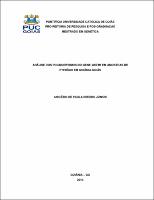| Compartilhamento |


|
Use este identificador para citar ou linkar para este item:
http://tede2.pucgoias.edu.br:8080/handle/tede/2378| Tipo do documento: | Dissertação |
| Título: | ANÁLISE DOS POLIMORFISMOS DO GENE GSTM1 EM AMOSTRAS DE PTERÍGIO EM GOIÂNIA-GOIÁS. |
| Autor: | Ribeiro Junior, Anicezio de Paula  |
| Primeiro orientador: | Moura, Katia Karina Verolli de Oliveira |
| Resumo: | Os primeiros relatos sobre pterígio datam da época de Hipócrates, mesmo assim essa condição ainda esconde mistérios sobre sua patogenia de forma tal que ainda nos dias de hoje pode ameaçar a saúde da visão de inúmeras pessoas. É uma formação fibrosa de conjuntiva cresce exageradamente e de forma anormal sobre a córnea, sendo composta por tecido epitelial e subepitelial, e altamente vascularizada. Um grande número de fatores está relacionado com a patogenia do pterígio tais como, aspectos físicos, calor, poeira e outras partículas presentes na atmosfera; e fatores biológicos como certos mecanismos imunológicos, mecanismos que envolvem a reorganização da matriz celular, fatores de crescimento, citocinas, apoptose e fatores angiogênicos. O pterígio acomete indivíduos que habitam principalmente países de clima tropical, localizados próximo à linha do Equador e que trabalham expostos ao sol; assim, a incidência é maior na região entre 40 graus de latitude ao norte e ao sul do Equador. Considerando a necessidade de investigar melhor a associação entre os polimorfismos do GSTM1 e a formação do pterígio, o presente trabalho tem o objetivo analisar essa relação. A análise do polimorfismo do gene GSTM1 para o grupo caso constatou que há diferença significativa entre o genótipo nulo do gene GSTM1 nos grupos caso e controle. O genótipo nulo do gene GSTM1 é estatisticamente significante na população masculina, mas não na feminina. O genótipo nulo do gene GSTM1 é estatisticamente significante na etnia branca, mas não na parda ou negra. O genótipo nulo do gene GSTM1 não está relacionado aos fatores de risco analisados: casos na família, exposição ocupacional, fumo, hipertensão e diabetes. |
| Abstract: | The first reports about pterygium date back to Hippocrates. This disease still hides mysteries about its pathogenesis in a way that even today it threaten vision health of many people around the world. It is a formation of fibrous tissue that grows excessively and with an abnormal shape on the cornea The anomaly consists of epithelial and subepithelial tissue and it is highly vascularized. A large number of factors are associated with the pathogenesis of pterygium such as physical factors: heat, dust and other particles in the atmosphere; and biological factors such as immunological mechanisms, mechanisms that involve the reorganization of the extracellular matrix, growth factors, cytokines, apoptosis, and angiogenic factors. The pterygium affects individuals who mainly inhabit tropical countries located near the equator and who working out in the sun; thus, the incidence is higher in the region between 40 degrees latitude north and south of the Equator. Considering the need to further investigate the association between GSTM1 polymorphisms and the formation of pterygium, this paper aims to analyze this relationship. The analysis of the null polymorphism of the GSTM1 gene for the case group found a significant difference between the GSTM1 null genotype in case and control groups. The null genotype of the GSTM1 gene is statistically significant in males, but not in female. The null genotype of the GSTM1 gene is statistically significant in Caucasians, but not in Brown or Black. The GSTM1 null genotype is not related to the risk factors analyzed: cases in family, occupational exposure, smoking, hypertension and diabetes. |
| Palavras-chave: | GST GSTM1 pterígio polimorfismo GST GSTM1 pterygium polymorphism |
| Área(s) do CNPq: | CNPQ::CIENCIAS BIOLOGICAS::GENETICA |
| Idioma: | por |
| País: | BR |
| Instituição: | Pontifícia Universidade Católica de Goiás |
| Sigla da instituição: | PUC Goiás |
| Departamento: | Ciências Humanas |
| Programa: | Genética |
| Citação: | RIBEIRO JUNIOR, Anicezio de Paula. ANÁLISE DOS POLIMORFISMOS DO GENE GSTM1 EM AMOSTRAS DE PTERÍGIO EM GOIÂNIA-GOIÁS.. 2014. 50 f. Dissertação (Mestrado em Ciências Humanas) - Pontifícia Universidade Católica de Goiás, GOIÂNIA, 2014. |
| Tipo de acesso: | Acesso Aberto |
| URI: | http://localhost:8080/tede/handle/tede/2378 |
| Data de defesa: | 18-Jun-2014 |
| Aparece nas coleções: | Mestrado em Genética |
Arquivos associados a este item:
| Arquivo | Descrição | Tamanho | Formato | |
|---|---|---|---|---|
| ANICEZIO DE PAULA RIBEIRO JUNIOR.pdf | 2,04 MB | Adobe PDF |  Baixar/Abrir Pré-Visualizar |
Os itens no repositório estão protegidos por copyright, com todos os direitos reservados, salvo quando é indicado o contrário.




